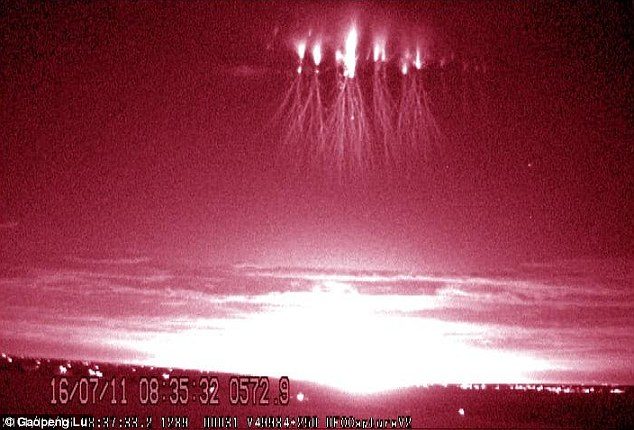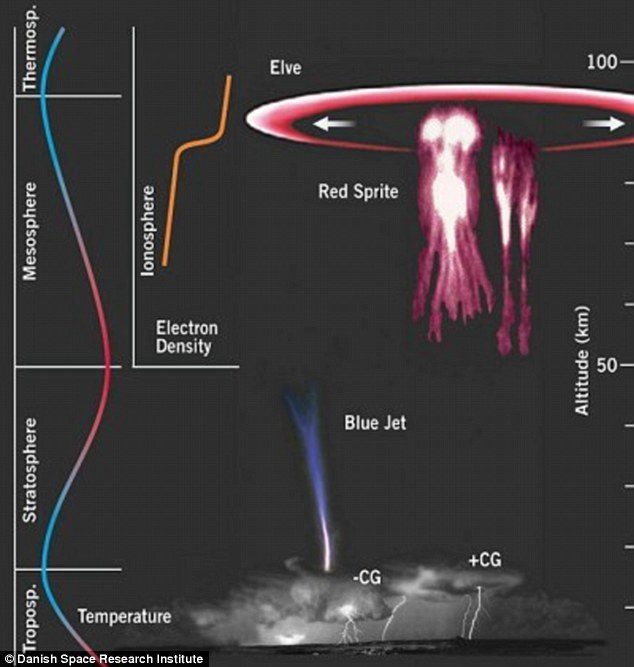
This striking form of lightning appears in the upper atmosphere, sitting above the thunderstorms themselves.
Now, scientists have observed the 'parent' lightning strokes for dozens of red sprites over a storm in China, revealing new insight on how these remarkable phenomena are produced.
Sprites appear as vertical streaks above thunderstorms at an altitude of about 24 to 55 miles (40 to 90 kilometers).
They fall within what are known as transient luminous events (TLES).

These were observed using a long-baseline lightning location network made up of very-low-frequency/low-frequency magnetic field sensors.
Based on the Lightning Effects Research Platform (LERP), the team was able to identify the parent strokes of more than 30 red sprites for that particular storm.
'This is probably the most productive sprite-producing thunderstorm system ever reported in China,' says Dr. LU Gaopeng, the corresponding author of the study.
The storm was what's known as a mesoscale convective system, in which a group of thunderstorms act like a single system.
The researchers found that the sprite producing lightning bolts occurred primarily during the system's mature stage, and behaved similarly to those seen over North America and Europe.
In the continental US, researchers have found similar results in an analysis of more than 2000 sprite-producing strokes.
Transient luminous events such as red sprites include several different types of stunning phenomena, such as blue jets and so-called 'elves.'
Given their appearance above storms, however, they're difficult to study.
When they are spotted, it's often by pilots and even astronauts on the International Space Station.
Comment: TLE activity has increased considerably in recent years and amateur photographers are just as likely to capture them as astronauts: Changing atmosphere: Red sprites and a blue jet seen above Europe's stormy skies
'Satellites have probed them and observations have even been made from mountain tops but their viewing angle is not ideal for gathering data on large scales,' the European Space Agency explains.
'In contrast, the International Space Station's low orbit covers a large part of Earth along the equator and is ideally placed to capture the sprites and jet.'
The latest research sheds new light on the behaviour of these elusive phenomena occurring high above the surface.
WHAT ARE 'RED SPRITES'?
Red sprites are electrical bursts of light that occur above highly active thunderstorms.
They can be seen in the D region of the ionosphere - the area just above the dense lower atmosphere, about 37 to 56 miles above the Earth.
They show up red at higher altitudes and fade to blue at lower heights.
Atmospheric sprites have been known for nearly a century, but their origins were a mystery.
They only last a few milliseconds and are relatively dim compared with other lightning.
The late experimental physicist John Winckler accidentally discovered sprites, while helping to test a new low-light video camera in 1989.



Comment: So scientists have a better idea of where sprites originate, but as of right now, few seem to have been able to identify why they, and a variety of other atmospheric phenomena, have surged in recent years:
- Chemtrails, Disinformation and the Sixth Extinction
- Our changing atmosphere: Stunning iridescent cloud over Mexico, complex solar halo over Russia and a triple rainbow over Norway
- Rare green flash sunset photographed flickering into even rarer blue in Norway
- Rare blue auroras seen in the Arctic Circle
- Strange auroral arc 'STEVE' observed in US, farther south than usual
- 'Strange' Arctic rainbow and red 'summer' sprites in winter - rare atmospheric events on the increase
- Strange skies: Red Sprites in Oklahoma, aurora Steve in Canada, iridescent clouds in Illinois and noctilucent clouds in Denmark
Also check out SOTT radio's: